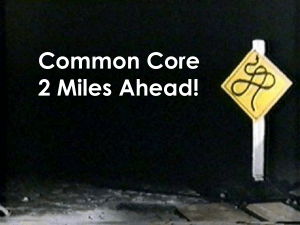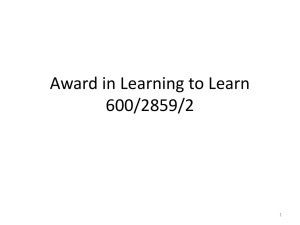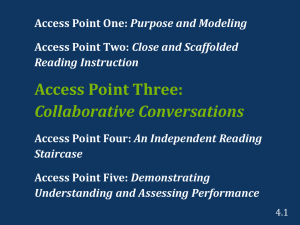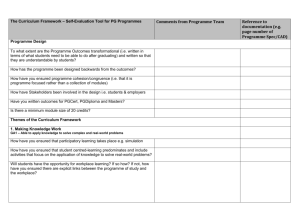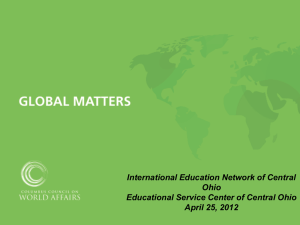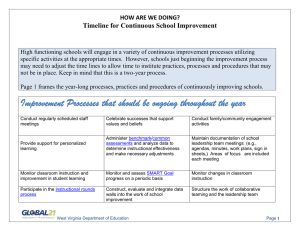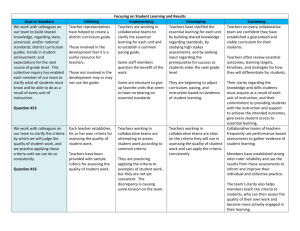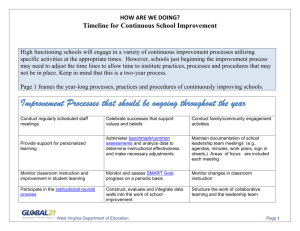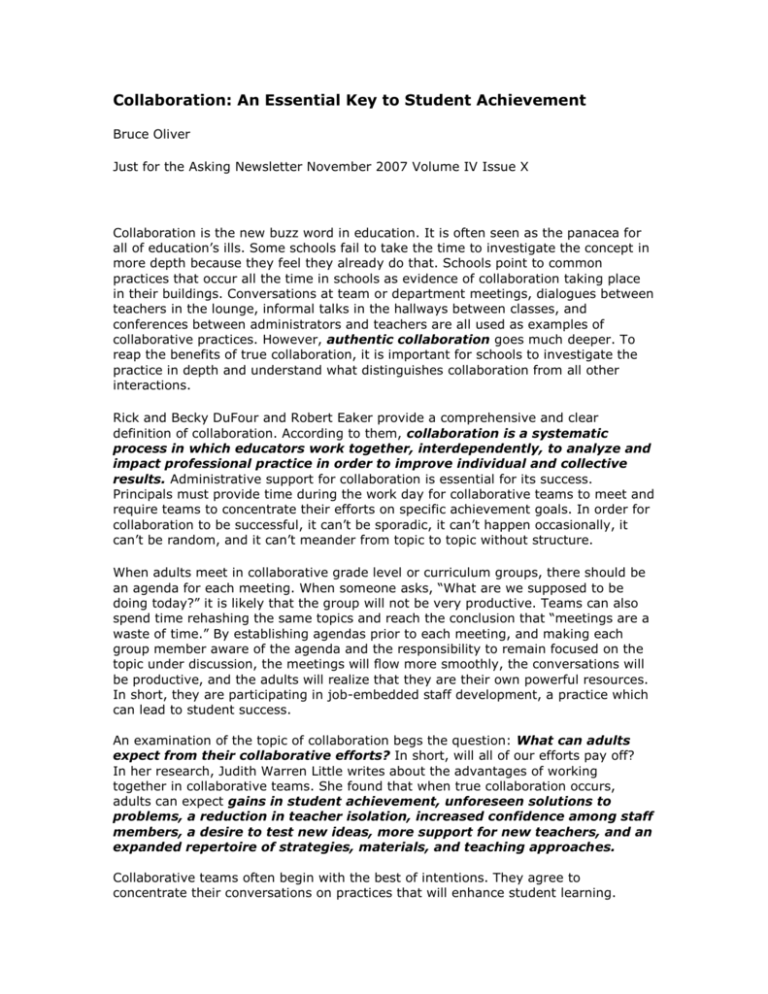
Collaboration: An Essential Key to Student Achievement
Bruce Oliver
Just for the Asking Newsletter November 2007 Volume IV Issue X
Collaboration is the new buzz word in education. It is often seen as the panacea for
all of education’s ills. Some schools fail to take the time to investigate the concept in
more depth because they feel they already do that. Schools point to common
practices that occur all the time in schools as evidence of collaboration taking place
in their buildings. Conversations at team or department meetings, dialogues between
teachers in the lounge, informal talks in the hallways between classes, and
conferences between administrators and teachers are all used as examples of
collaborative practices. However, authentic collaboration goes much deeper. To
reap the benefits of true collaboration, it is important for schools to investigate the
practice in depth and understand what distinguishes collaboration from all other
interactions.
Rick and Becky DuFour and Robert Eaker provide a comprehensive and clear
definition of collaboration. According to them, collaboration is a systematic
process in which educators work together, interdependently, to analyze and
impact professional practice in order to improve individual and collective
results. Administrative support for collaboration is essential for its success.
Principals must provide time during the work day for collaborative teams to meet and
require teams to concentrate their efforts on specific achievement goals. In order for
collaboration to be successful, it can’t be sporadic, it can’t happen occasionally, it
can’t be random, and it can’t meander from topic to topic without structure.
When adults meet in collaborative grade level or curriculum groups, there should be
an agenda for each meeting. When someone asks, “What are we supposed to be
doing today?” it is likely that the group will not be very productive. Teams can also
spend time rehashing the same topics and reach the conclusion that “meetings are a
waste of time.” By establishing agendas prior to each meeting, and making each
group member aware of the agenda and the responsibility to remain focused on the
topic under discussion, the meetings will flow more smoothly, the conversations will
be productive, and the adults will realize that they are their own powerful resources.
In short, they are participating in job-embedded staff development, a practice which
can lead to student success.
An examination of the topic of collaboration begs the question: What can adults
expect from their collaborative efforts? In short, will all of our efforts pay off?
In her research, Judith Warren Little writes about the advantages of working
together in collaborative teams. She found that when true collaboration occurs,
adults can expect gains in student achievement, unforeseen solutions to
problems, a reduction in teacher isolation, increased confidence among staff
members, a desire to test new ideas, more support for new teachers, and an
expanded repertoire of strategies, materials, and teaching approaches.
Collaborative teams often begin with the best of intentions. They agree to
concentrate their conversations on practices that will enhance student learning.
However, over time, reality sets in. The initial excitement wanes as teachers become
tired, overburdened, mired in paper work, or distracted by unforeseen events. They
want to retain their commitment to student learning but may need some additional
inspiration to spur them on to meet their collaborative goals. Listed below are a
series of topics/questions that will help curriculum or grade level teams regain their
focus and eventually maintain the momentum they established when they began
working together. The topics or questions will potentially lead to lively discussions,
significant sharing, increased adult learning, and ultimately improve student
achievement.
Maintaining the Momentum – Keeping Powerful Conversations Alive
1.
A successful collaborative practice is for teams to create products such as
common assessments or units. Members then administer the assessments
and bring data from the assessments to a team meeting for analysis and
discussion.The resulting conversations can lead to greater insights into how
peers teach their content, and how students reach desired learning goals.
2.
Since most of the reading that students will do after they leave school is
non-fiction, spend time talking about how to include non-fiction reading or
writing in your grade level or content area.
3.
Discuss creative formative or summative assessments that a team
member has used, especially any performance assessments.
4.
Scaffolding is a temporary support that a teacher puts into place in the
classroom as students are learning. Have team members share successful
scaffolding strategies they have used.
5.
Student learning can be enhanced when a teacher provides important
background knowledge on the topic that will be the focus of the day’s
lesson. Have team members share activating strategies they have used to
prepare students for the day’s lesson.
6.
Also, it is important for students, not the teacher, to summarize their
learning at the end of a class period. Team members can take the time to talk
about summarizing activities they have used.
7.
It is important for teachers to carry out pre-assessments at the beginning
of units. Take time at a team meeting to talk about pre-assessment options.
8.
The more active students are in the learning process, the better the brain
functions and the more permanent the learning will be. There are numerous
active learning strategies teachers can use. At a meeting, teachers can
share strategies that they have used or can use in the future with their
students.
9.
Many teachers worry about end-of-the-year standardized tests. When
student thinking is challenged at the three highest levels of Bloom’s taxonomy
(analysis, synthesis, evaluation), student learning is improved and
students can recall the factual information that can become the focus of many
classrooms. Team members can discuss how they can plan in order to focus
on Bloom’s higher levels.
10.
Visual learners can benefit greatly from the use of graphic organizers.
Have group members spend time talking about the different types of graphic
organizers, how they are best used, and sources of information about
different organizers they may want to try.
11.
Successful teachers use different inventories or questionnaires at the
beginning of the school year in order to get to know their students, different
interests their students may have, and how their students learn best. Team
members can discuss the different inventories that exist and how they can be
used to help adults know their students better.
12.
Some teachers establish anchoring activities that reinforce, enrich, or
extend learning. When students complete a particular learning activity early,
they are expected to “go to” and complete an anchoring activity. Activities
may include readings, cumulative review sheets, computer work or other
ideas teachers develop. Team members can discuss the different types of
anchoring activities that work or might work in their individual classrooms.
13.
Examining student work can be a valuable use of time. There is often
discrepancy from teacher to teacher in determining what constitutes rigorous
work. Team members can bring work samples to team meetings and discuss
how they go about assessing student work.
14.
Student learning can be significantly enhanced through the use of
technology. Students are frequently way ahead of adults with their knowledge
of technology. It is important for adults to be as current as possible in the use
of instructional technology and team time spent talking about technology
integration can be a valuable use of time.
15.
Some adults are adept at analyzing student achievement data; some are
not. Looking at student data and talking about different approaches to data
analysis can lead to improved planning, pacing, and instructional
implementation.
16.
It is important for teachers to make sure that their lessons focus on the
essential knowledge or essential understandings they want to result
from their teaching. Some teachers may be unclear about what essential
understanding should result from their efforts with students. Time spent
discussing essential understandings can be an important clarifying activity
and good use of team time.
17.
Outstanding teachers have an extensive repertoire of learning strategies
which they can match to students’ needs. One important teaching skill is
checking for understanding. Teachers can spend time talking about
different checks they have used.
18.
Some curriculum teams establish SMART goals that the team will
implement. SMART stands for specific, measurable, attainable, results-
oriented, and time-bound. Successful teams not only talk about SMART goals
but they establish quarterly goals for student learning.
It is important to remember that when adults stop learning, so do students.
Collaboration can be the vehicle that helps adults become lifelong learners. The
excitement and enthusiasm that can be derived from collaborative planning can
make the job of teaching exciting and fulfilling. The big payoff, however, is when
teachers see the achievement results that can be derived from working together.
© 2007 Just ASK Publications & Professional Development.
Permission is granted for reprinting and distribution of this newsletter for noncommercial use only. Please include the following citation on all copies:
Oliver, Bruce. "Collaboration: An Essential Key to Student Achievement” Just for
the ASKing! November 2007, http://www.askeducation.com/newsletter.htm.
Reproduced with permission of Just ASK Publications & Professional Development
(Just ASK), Inc. Copyright 2007 by Just ASK, Inc. All rights reserved.



